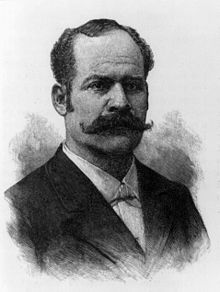José Santos Zelaya
| José Santos Zelaya | |
|---|---|
 |
|
| President of Nicaragua | |
|
In office 25 July 1893 – 21 December 1909 |
|
| Vice President | Anastasio J. Ortiz 1893–1894 Francisco Baca 1894–1896 |
| Preceded by | Joaquín Zavala |
| Succeeded by | José Madriz |
| Personal details | |
| Born |
José Santos Zelaya López 1 November 1853 Managua |
| Died | 17 May 1919 (aged 65) New York City |
| Political party | Liberal Party |
José Santos Zelaya López (1 November 1853 Managua – 17 May 1919 New York City) was the President of Nicaragua from 25 July 1893 to 21 December 1909.
He was a son of José María Zelaya Irigoyen, born in Nicaragua, and his mistress Juana López Ramírez. His father José María was married to Rosario Fernández.
Zelaya was of Nicaragua's liberal party and enacted a number of progressive programs, including improving public education, building railroads, and establishing steam ship lines and enacting constitutional rights that provided for equal rights, property guarantees, habeas corpus, compulsory vote, compulsory education, the protection of arts and industry, minority representation, and the separation of state powers. However, his wish for national sovereignty often led him to policies contrary to colonialist interests.
In 1894, he took control of the Mosquito Coast by military force; it had long been the subject of dispute, home to a native kingdom claimed as a protectorate by the British Empire. Indeed, Nicaragua and before Spain, had always claimed the Caribbean Coast of this country, but the "Zambos" pirates (former African runaway slaves mixed with local Indians) and part of the Misquito Indians (probably with the Sumos and Ramas as well), together with the military support of the British Marines, tried to create a colonial British settlement (Greytown, nowadays Puerto Zelaya). This is similar to the cases of Belize and Guatemala, except that Belize has been an Independent Nation since 1981. Zelaya's fortitude paid off, and the United Kingdom, probably not wishing to go to war for this distant land of the Empire, recognized Nicaraguan sovereignty over the area. The strategic value of this land led to the name "Vía del Tránsito" ("Route of Traffic"). Both the United Kingdom and the USA wanted the control of this route that connected the Caribbean Sea with the Pacific Coast across the San Juan River and the Nicaraguan Lake. At this point, the Panama Canal did not exist, and the USA was rising as the new continental power. Cornelius Vanderbilt became the owner of the steamboats in the San Juan River, but he was later expropriated by William Walker. After 1856/1858 Central American War, Costa Rica, allied with some Nicaraguans Nationalists forces and later with the Armies of the three other Republics of Central America, were defeated in a bloody war by the North American Filibuster William Walker. Walker wanted to annex these five Independent Republics to the USA and bring back slavery in Central America, which had was abolished since 1824. Years later, the Nicaraguan Conservative party became opposed to foreign invasion, because of the Liberal internal divisions during Walker's occupation. Nonetheless, Conservative Oligarchy (mainly from Granada in the South) was later incapable of modernizing all Nicaragua. On the contrary, Zelaya was a Liberal member of the military, as well as an educated leader, a regular Freemason, and an Anti-imperialist fighter. He had the support of other Liberal leaders of Central America (Guatemala and Costa Rica had a Liberal Revolution in 1870, El Salvador as well).
...
Wikipedia
